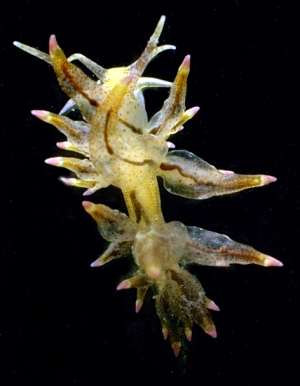
Dunga ocellata
(Alder & Hancock, 1864)
Order: NUDIBRANCHIA
Suborder: AEOLIDINA
Family: Eubranchidae
DISTRIBUTION
Indo-west Pacific
PHOTO
North Reef (sewer pipe), entrance to Dar es Salaam Harbour, Tanzania. DSM26, 16 August 1973. Photos: Bill Rudman
Relatively small aeolids with up to 5 rows of cerata on each side, 2 in front of the heart, 3 behind. There are up to 5 cerata in each row. The inner cerata in the anterior rows are enormous, some almost half the size of the whole body. The cerata can change shape considerably, and at their largest are greatly inflated, the basal two-thirds being cylindrical and the upper third tapering to a point. A ring of 7 - 8 tubercles form a ring around the ceras at about a third the way from the tip. The ceratal wall is transparent with a scattering of small brown and opaque white specks, the density of which varies in different animals. Also present are some small red rings each filled with an orange-yellow colour. These rings are usually very small, almost indistinguishable from the red spots, but in some animals they are much larger. Within an individual the rings can become larger when the cerata become inflated. The tip of each ceras is reddish pink, below which can be a white ring and a yellowish band. The digestive gland duct in each ceras is a thin tube, usually brown in colour.
The animal is transparent colourless with the yellowish viscera showing through the body wall. There are scattered brown spots all over the body, rhinophores and oral tentacles, often aggregated into bands and patches.
Alder & Hancock (1864) described this species as Eolis ocellata, from Waltair on the Bay of Bengal coast of what is now Andrha Pradesh State in northeastern India [see message #13245 ]. It is distinguished from species of Eubranchus by its tentacular anterior foot corners. It has been well described by Edmunds (1969) from Tanzania, where it is a relatively common species. The tentacular foot corners, swollen nodulose cerata, and red rings are also features of Dunga nodulosa Eliot, 1902, from Tanzania and I consider them to be the same species. I have followed Edmunds in leaving this species in the genus Dunga, although a further review of the family may consider it to be a synonym of Eubranchus.
Apart from Alder & Hancock's and Eliot's records of this species, it has also been reported from Tanzania (Edmunds, 1969), and in the Forum from the Red Sea [Oren Lederman message #13214], Tanzania [Bill Rudman message #13249], and New Caledonia [Bill Rudman message #13239], suggesting it has a wide Indo-West Pacific distribution
-
Alder, J. & Hancock, A. (1864) Notice of a collection of nudibranchiate mollusca made in India by Walter Elliot Esq., with descriptions of several new genera and species. Transactions of the Zoological Society of London, 5: 113-147.
-
Eliot, C.N.E. (1902) On some nudibranchs from Zanzibar. Proceedings of the Zoological Society of London, 1902(2): 62-72. (Pls.5-6)
-
Edmunds, M. (1969) Opisthobranchiate Mollusca from Tanzania I. Eolidacea (Eubranchidae and Aeolidiidae). Proceedings of the Malacological Society of London, 38: 451-469.
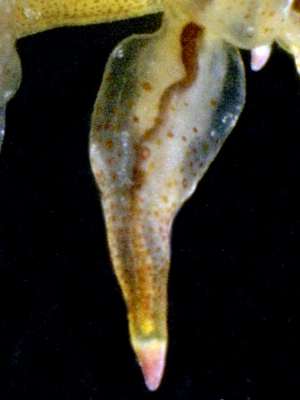
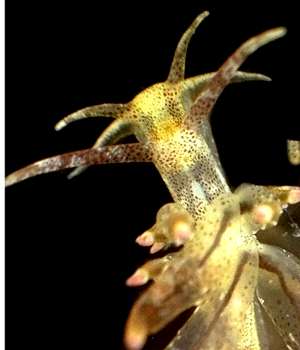
Rudman, W.B., 2005 (March 3) Dunga ocellata (Alder & Hancock, 1864) . [In] Sea Slug Forum. Australian Museum, Sydney. Available from http://www.seaslugforum.net/find/dungocel
Related messages
Dunga ocellata from Sulawesi
October 7, 2008
From: Heidi Hösel
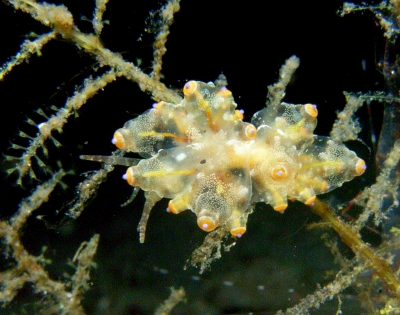
Hi Bill,
This translucent beauty was was found together with two further specimen during a night dive feeding on this hydrozoan colony. The most similar I found in the databases was Eubranchus cf. rubropunctatus, especially having regard to the smooth rhinophores. Could you please help in its identification?
Locality: Pantai Parigi, Lembeh strait N- Sulawesi, 18 m, Indonesia, W-Pacific, 23 August 2006, sandy slope with some rubble. Length: about 1.5 cm. Photographer: Heidi Hösel.
Thank you in advance,
Heidi Hösel
hhoesel@gmx.de
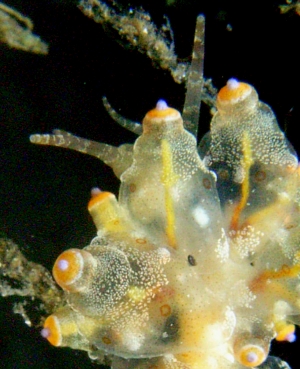
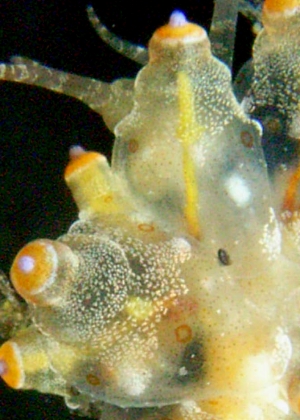
Dear Heidi,
Your suggestion of it being a species of Eubranchus is almost correct. It is Dunga ocellata which is a genus which differs only slightly. The shape of the cerata and the red rings are very characteristic.
Best wishes,
Bill Rudman
Dunga ocellata from the Red Sea
March 2, 2005
From: Oren Lederman
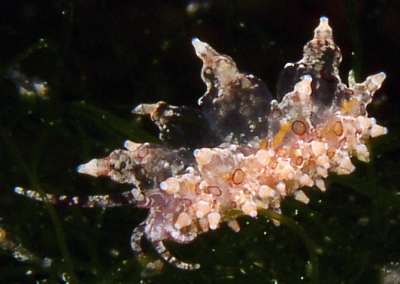
Hi Bill,
Couldn't identify this wierd looking slug...
There were a few more semi-transparent slugs there, but I just couldn't focus or take photos of them.
Locality: Near the "Yetush" ( mosquito) shipwreck, Eilat Bay (night dive), Israel, Red Sea. Depth: ~22 meters. Length: 3-4 cm.18 Feb 2005. Photographer: Oren Lederman
Oren Lederman
lederman@bigmail.co.il
Lederman, O., 2005 (Mar 2) Dunga ocellata from the Red Sea. [Message in] Sea Slug Forum. Australian Museum, Sydney. Available from http://www.seaslugforum.net/find/13214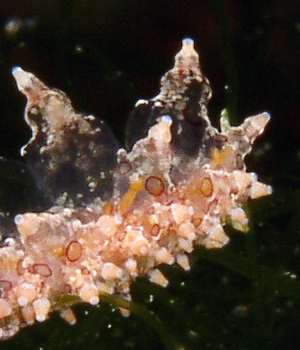
Dear Oren,
This is an interesting find. It is Dunga ocellata, originally described from north-eastern India in 1864. It was also described from Zanzibar as Dunga nodulosa in 1902. I found it quite commonly in the 1970s while I was living in Dar es Salaam [message #13249], and in a separate message [#13239 ] I report finding it in New Caledonia.
It has large inflated cerata, bearing a ring of tubercles about a third of the way down from the tip, but the shape of the cerata is quite plastic sometimes they are very inflated, other times quite thin. The red rings on the cerata are quite characteristic of the species.
Best wishes,
Bill Rudman
Dunga ocellata from New Caledonia
March 2, 2005
From: Bill Rudman
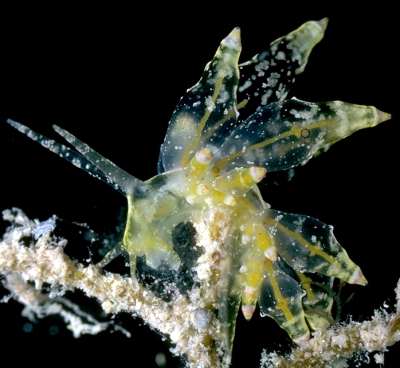
To accompany my other messages on Dunga ocellata [message #13245 ], here is a record of specimens from New Caledonia.
Locality: Passe du Baron, off Koumac, New Caledonia, 20°33.7'S, 164°10.3'E, 12m, In lagoon, sand with Heteropsammia, 14 October 1993, 5, 6, 6,10 mm long alive, AM C200481. Photos: Bill Rudman.
In these specimens opaque white speckling is quite prominent, but the reddish brown spots and reddish rings are also present. This is the first record of the species from the Pacific Ocean.
Bill Rudman
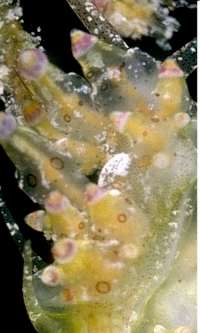
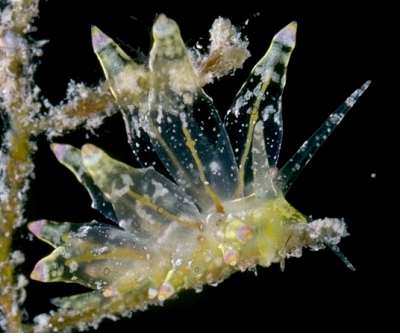
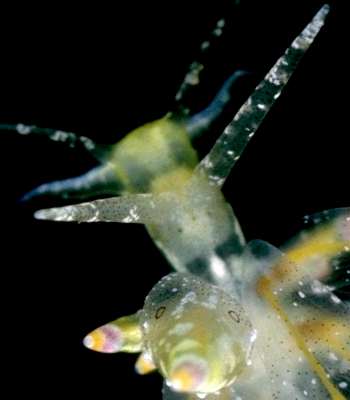
This photo of the head shows the tentaculate anterior foot corners, the white specling and red-brown spots on the head. On the ceras the pink and yellow bands near the tip are evident and the red rings around the level of the pustules.
The identity of Eolis ocellata Alder & Hancock
March 2, 2005
From: Bill Rudman
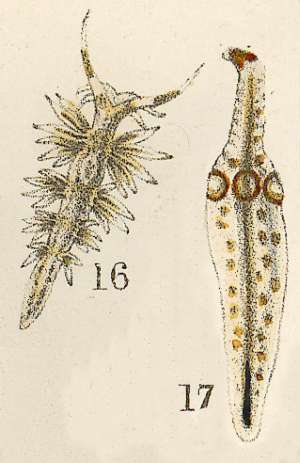
Alder & Hancock (1864) described a species of aeolid, Eolis ocellata, from Waltair on the Bay of Bengal coast of what is now Andrha Pradesh State in northeastern India
PHOTOS: Eolis ocellata Alder & Hancock, 1864: Pl.33, figs 16-17.
Alder & Hancock's following short description was accompanied by the attached two colour paintings, one of the whole animal, and one of a ceras:
'Branchial papillae rather inflated for about two-thirds up, when they become suddenly contracted, and linear towards the apex, which is encircled with brown: five or six brown rings form a chain like circle round the upper part of the inflated portion, the rest of the surface is white spotted with yellow, and there is a narrow brown central gland: the papillae are set in four clusters, the front ones the largest. Foot with the angles produced into long tentacular processes in front, rather broad and fin-like towards the tail. Length about 3/4ths of an inch.
The shape and colour of the cerata, and the tentacular anterior foot corners show that this is the same species as Eliot (1902) described from Tanzania as Dunga nodulosa. Its name therefore should be Dunga ocellata. As well as these two published records, further specimens have been reported from Tanzania (Edmunds, 1969) and in the Forum from the Red Sea [Oren Lederman message #13214], Tanzania [Bill Rudman message #13249], and New Caledonia [Bill Rudman message #13239 ], suggesting it has a wide Indo-West Pacific distribution
-
Alder, J. & Hancock, A. (1864) Notice of a collection of nudibranchiate mollusca made in India by Walter Elliot Esq., with descriptions of several new genera and species. Transactions of the Zoological Society of London, 5: 113-147.
-
Eliot, C.N.E. (1902) On some nudibranchs from Zanzibar. Proceedings of the Zoological Society of London, 1902(2): 62-72. (Pls.5-6)
-
Edmunds, M. (1969) Opisthobranchiate Mollusca from Tanzania I. Eolidacea (Eubranchidae and Aeolidiidae). Proceedings of the Malacological Society of London, 38: 451-469.
Dunga ocellata from Tanzania
March 2, 2005
From: Bill Rudman
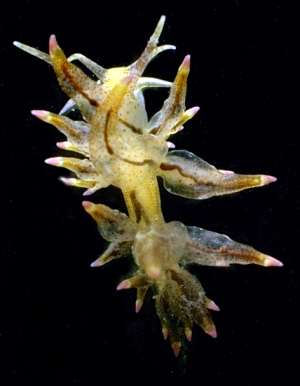
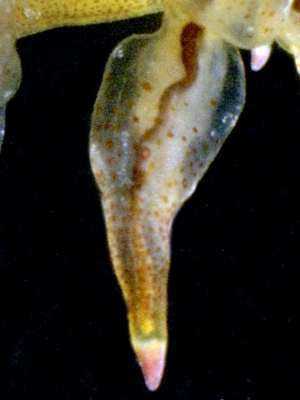
To accompany my other messages on Dunga ocellata [message #13245 ], here is a record of specimens from Dar es Salaam, Tanzania.
Locality: North Reef (sewer pipe), entrance to Dar es Salaam Harbour, Tanzania. DSM26, 16 August 1973. Photos: Bill Rudman
12 specimens ranging in size from 17-8mm in length. The transparent skin of the body and cerata were covered in red-brown specks. No other colour was present except for the yellow and reddish bands at the tip of the cerata. In other specimens found in Dar es Salaam, white specks were also present.
Bill Rudman
Rudman, W.B., 2005 (Mar 2) Dunga ocellata from Tanzania. [Message in] Sea Slug Forum. Australian Museum, Sydney. Available from http://www.seaslugforum.net/find/13249